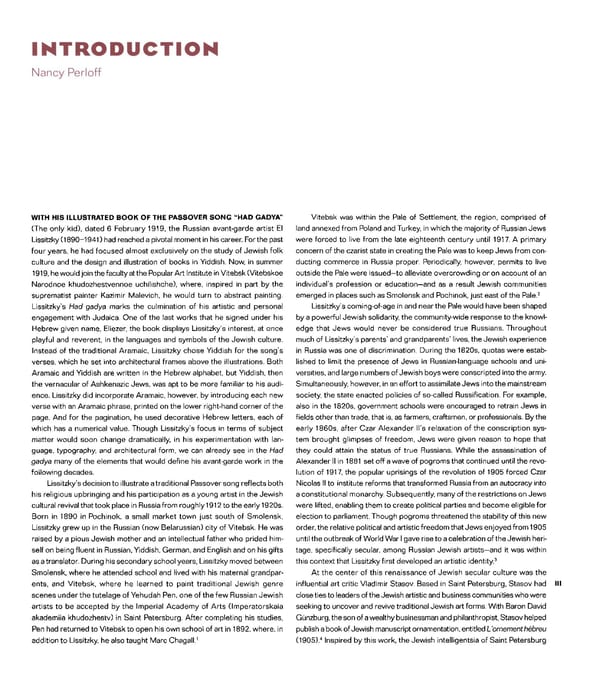INTRODUCTION Nancy Perloff WITH HIS ILLUSTRATED BOOK OF THE PASSOVER SONG "HAD GADYA" Vitebsk was within the Pale of Settlement, the region, comprised of (The only kid), dated 6 February 1919, the Russian avantgarde artist El land annexed from Poland and Turkey, in which the majority of Russian Jews Lissitzky (18901941) had reached a pivotal moment in his career. For the past were forced to live from the late eighteenth century until 1917. A primary four years, he had focused almost exclusively on the study of Jewish folk concern of the czarist state in creating the Pale was to keep Jews from con culture and the design and illustration of books in Yiddish. Now, in summer ducting commerce in Russia proper. Periodically, however, permits to live 1919, he would join the faculty at the Popular Art Institute in Vitebsk (Vitebskoe outside the Pale were issued—to alleviate overcrowding or on account of an Narodnoe khudozhestvennoe uchilishche), where, inspired in part by the individual's profession or education—and as a result Jewish communities 2 suprematist painter Kazimir Malevich, he would turn to abstract painting. emerged in places such as Smolensk and Pochinok, just east of the Pale. Lissitzky's Had gadya marks the culmination of his artistic and personal Lissitzky's comingofage in and near the Pale would have been shaped engagement with Judaica. One of the last works that he signed under his by a powerful Jewish solidarity, the communitywide response to the knowl Hebrew given name, Eliezer, the book displays Lissitzky's interest, at once edge that Jews would never be considered true Russians. Throughout playful and reverent, in the languages and symbols of the Jewish culture. much of Lissitzky's parents' and grandparents' lives, the Jewish experience Instead of the traditional Aramaic, Lissitzky chose Yiddish for the song's in Russia was one of discrimination. During the 1820s, quotas were estab verses, which he set into architectural frames above the illustrations. Both lished to limit the presence of Jews in Russianlanguage schools and uni Aramaic and Yiddish are written in the Hebrew alphabet, but Yiddish, then versities, and large numbers of Jewish boys were conscripted into the army. the vernacular of Ashkenazic Jews, was apt to be more familiar to his audi Simultaneously, however, in an effort to assimilate Jews into the mainstream ence. Lissitzky did incorporate Aramaic, however, by introducing each new society, the state enacted policies of socalled Russification. For example, verse with an Aramaic phrase, printed on the lower righthand corner of the also in the 1820s, government schools were encouraged to retrain Jews in page. And for the pagination, he used decorative Hebrew letters, each of fields other than trade, that is, as farmers, craftsmen, or professionals. By the which has a numerical value. Though Lissitzky's focus in terms of subject early 1860s, after Czar Alexander N's relaxation of the conscription sys matter would soon change dramatically, in his experimentation with lan tem brought glimpses of freedom, Jews were given reason to hope that guage, typography, and architectural form, we can already see in the Had they could attain the status of true Russians. While the assassination of gadya many of the elements that would define his avantgarde work in the Alexander II in 1881 set off a wave of pogroms that continued until the revo following decades. lution of 1917, the popular uprisings of the revolution of 1905 forced Czar Lissitzky's decision to illustrate a traditional Passover song reflects both Nicolas II to institute reforms that transformed Russia from an autocracy into his religious upbringing and his participation as a young artist in the Jewish a constitutional monarchy. Subsequently, many of the restrictions on Jews cultural revival that took place in Russia from roughly 1912 to the early 1920s. were lifted, enabling them to create political parties and become eligible for Born in 1890 in Pochinok, a small market town just south of Smolensk, election to parliament. Though pogroms threatened the stability of this new Lissitzky grew up in the Russian (now Belarussian) city of Vitebsk. He was order, the relative political and artistic freedom that Jews enjoyed from 1905 raised by a pious Jewish mother and an intellectual father who prided him until the outbreak of World War I gave rise to a celebration of the Jewish heri self on being fluent in Russian, Yiddish, German, and English and on his gifts tage, specifically secular, among Russian Jewish artists—and it was within 3 as a translator. During his secondary school years, Lissitzky moved between this context that Lissitzky first developed an artistic identity. Smolensk, where he attended school and lived with his maternal grandpar At the center of this renaissance of Jewish secular culture was the ents, and Vitebsk, where he learned to paint traditional Jewish genre influential art critic Vladimir Stasov. Based in Saint Petersburg, Stasov had III scenes under the tutelage of Yehudah Pen, one of the few Russian Jewish close ties to leaders of the Jewish artistic and business communities who were artists to be accepted by the Imperial Academy of Arts (Imperatorskaia seeking to uncover and revive traditional Jewish art forms. With Baron David akademiia khudozhestv) in Saint Petersburg. After completing his studies, Gunzburg, the son of a wealthy businessman and philanthropist, Stasov helped Pen had returned to Vitebsk to open his own school of art in 1892, where, in publish a book of Jewish manuscript ornamentation, entitled L'ornement hebreu 1 4 addition to Lissitzky, he also taught Marc Chagall. (1905). Inspired by this work, the Jewish intelligentsia of Saint Petersburg
 Had Gadya The Only Kid: Lissitzky 1919 Page 4 Page 6
Had Gadya The Only Kid: Lissitzky 1919 Page 4 Page 6